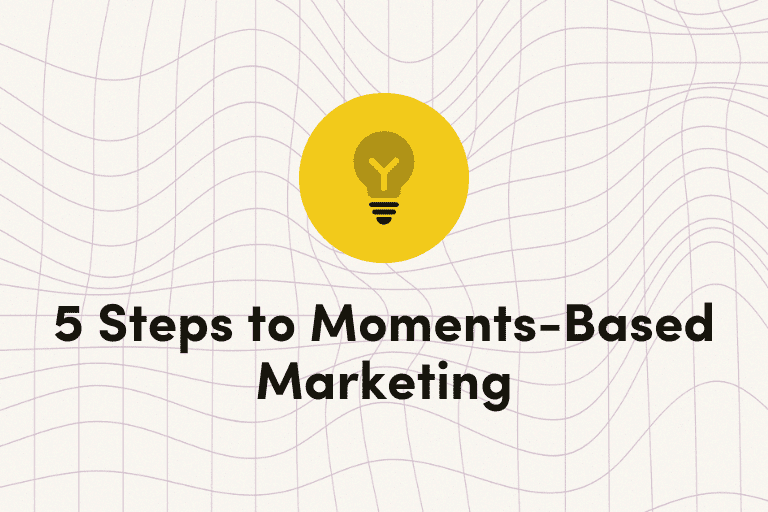Ask any industry professional what the goal of growth marketing is, and you may get 15 different answers.
Is it adoption of an experimentation mindset?
Is it product & marketing teams working together to create customer experience?
Or does growth have to do with expanding the role of marketing to include the entire funnel?
None of these things are wrong…
But I am 99% positive that you, the B2C marketer, are struggling to understand what this means for your brand.
So let me simplify it for you.
To fully embrace growth marketing, everything your company does—product, marketing, user experience—should be designed to help your customers grow.
Not sure what I mean? Let’s back up a little bit to make sure we’re on the same page.
How Growth Marketing Relates to Customer Lifetime Value
To further understand growth marketing, marketers need to look no further than the concept of customer lifetime value (otherwise known as CLTV).
Unfortunately, most articles about CLTV are about calculations and analyzing past behavior to make budgetary decisions.
This is great for your company’s growth—but not necessarily your customer’s growth.
MIT research fellow Michael Schrage knows this phenomenon well. In his book, Who Do You Want Your Customer to Become, he emphasizes the following…
“Customers are constantly becoming something else…they’re not finicky consumers passively expecting markets to please, satisfy or delight them; they’re actually dynamic collaborators and authors of their own futures…they want to make sure they’re going in the right direction.”
Meaning? Customer lifetime value has less to do with retaining existing customers…
And has more to do with “who tomorrow’s customers will and should be.”
As a marketer, Schrage recommends breaking down this amorphous question by simply filling in the blank below.
Our customers become much more valuable when ____________________.
And based on Schrage’s observations, companies who could answer that question brainstormed new customer capabilities, and eventually, created new ways for customers to increase their lifetime value.
3 Brands Disrupting Their Industries with Growth Marketing
Still confused? Let’s break down what growth marketing looks like for 3 brands that are leading their industry right now and beating out household names who currently struggle with a dwindling customer base.
Honest Company vs. Huggies & Pampers
Even though I’m a new mom, a lot of my peers are holding off on having kids.
Fewer kids means fewer diaper purchases, so profits aren’t looking great for diaper brands like Huggies and Pampers.
So how does a brand newcomer like The Honest Company grow to a valuation of just under $1 billion dollars in 8 short years?
Honest has since expanded into multiple product categories, but it’s clear actress Jessica Alba hit a nerve with new parents looking to make non-toxic choices for their babies—70% of Honest’s revenue is from their diaper subscription service.
Compare that to their competitors, who are struggling to catch up with high-tech and plant-based diaper offerings.
Honest’s growth trajectory can be summed up by this recent interview with Founder & CEO Christopher Gavigan:
“The consumer is smarter and more savvy and more emotionally attuned, and they can detect when they’re being pitched a marketing campaign as opposed to a deeply valued and purpose-driven brand ethos.”
In other words? Honest continues to grow because they believe so heavily in developing diapers that help customers embrace a chemical-free lifestyle…
And deliver it in a convenient subscription format to help their customers become more present and healthy parents to their children.
Fender vs. Gibson
When Fender entered the digital space a few years ago, they realized that their core customers weren’t professional musicians like Jimi Hendrix or Miley Cyrus.
More often than not, it is an aspiring guitarist who wants to sound like Jimi Hendrix.
The problem? 90% of first-time guitar players quit within 6 months.
So Fender hypothesized that if they could lower that number by a percentage, the impact on customer lifetime value could be substantial (since serious guitarists own multiple guitars).
From those insights (and a lot of customer research), they eventually created Fender Play, an app that provides bite-sized online lessons for guitarists and bassists just starting out.
Compare that to 125-year-old guitar manufacturer Gibson, who focused on innovations like an automatic tuning guitar and is now working their way out from bankruptcy status.
The difference? Gibson still sees themselves as a guitar manufacturer.
Fender sees themselves a business that helps their core customer—aspiring guitarists—learn how to play guitar using their equipment.
Savage X Fenty vs. Victoria’s Secret
Before Victoria’s Secret became the largest lingerie retailer in the world, they were primarily a catalog business.
However, all of that changed in 1979 when they sent two of their marketers to Joseph Sugarman’s copywriting seminar and subsequently wrote an ad titled, “Lingerie for Men.”
Ever since that moment, my opinion is that Victoria’s Secret marketing efforts have existed to, as the original ad implies, cater to the tastes of their male customers.
However, women no longer want their bodies held to a supermodel standard, which is why brands like Savage X Fenty are taking off with today’s females.
Launched by pop star Rihanna, Savage boasts lingerie for women of every size, shape and color. Since their debut at New York Fashion Week, they’ve received tons of praise for their message of empowerment and inclusivity and its debut collection sold out in a month.
Savage X Fenty’s long-term growth pattern remains to be seen, but it comes as a blow to Victoria’s Secret, who cancelled their fashion show, closed multiple stores, and faced intense media scrutiny thanks to their connection with Jeffrey Epstein.
It’s clear that in 2019, women are asking for lingerie brands to accept their bodies as they are, regardless of a man’s approval—and Savage X Fenty is helping them do that.
A Quick Recap
Whether it’s diapers, guitars, or lingerie, it’s evident that customers are asking for more from the brands they buy from, which explains why companies like Honest, Fender, and Savage X Fenty are disrupting their industries right now.
These 3 brands help their customers become better as a result of using their products or services and ignoring the standard business advice given about customer lifetime value.
So if you’re a B2C marketer trying to figure out what growth marketing means for your brand in 2019, take MIT research fellow Michael Schrage’s advice by asking your team the following question:
“What can we do to make our customers much more valuable?”
The more you focus on growing your customer, the easier it will be to embrace growth marketing—and eventually, grow your brand.
Curious to learn more about how growth marketing and customer lifetime value can impact your brand growth? Schedule a demo today!































